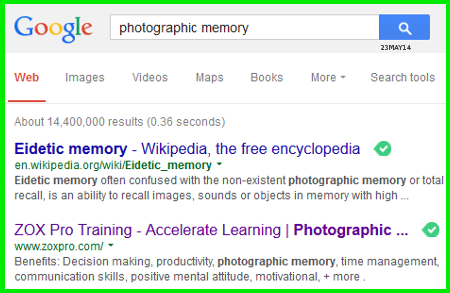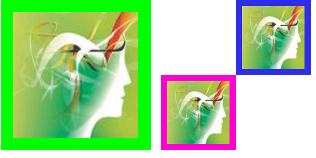The Photographic Memory – A Picture is Worth a Thousand Words
A Picture is Worth a Thousand Words …

Google.com search for Photographic Memory
The Photographic Memory …
ZOX Pro Training has been teaching people how to use their photographic memory since 1975. The parent organization, Educom, Inc., has been teaching the Mental Photography techniques in Brain Management training since the beginning. We released ZOX Pro Training onto the Internet in 2008. People around the world have benefited that would have never had access to our training otherwise.
The Picture …
The Google.com search pictured above is a snapshot of ZOX Pro Training’s unique place in the industry of alternative learning. Our techniques accelerate learning to all new levels that most people find incredible, starting at 25,000 words per minute. The brain exercises taught within the training strengthen your brain, gaining clarity, and the way it functions naturally by way of what is now referred to as neural-plasticity.
This picture signifies recognition by the Internet, and portrays the quality Richard Welch, the “Father of Mental Photography” had envisioned 39 years earlier.
The Eidetic Memory …
People are often confused by the difference between the eidetic memory and the photographic memory (eidetic memory vs photographic memory). You are born with the eidetic memory. This is how you learn everything when you are very young till around the age of 5. When you are born, you are a genius; an information sponge absorbing information faster than light speed, naturally, and with ALL of your senses. The best thing is you never lose your eidetic memory and the abilities it gives you. Most people are taught out of using it fluently.
The first recorded use of the words “photographic memory” is 1924. But we also know there are plenty of people from history before that time that demonstrate these abilities. Why then do many psychologists find the term so easy to discredit? First, and probably most importantly, the word “photographic” only refers to the visual sense, while “eidetic” refers to ALL of your senses. How silly! Someone was not able to remember the technical term “eidetic memory” so they simply made up a word close to the same meaning – the “photographic memory”.
Since the amount of information your brain takes in from vision is over ten times that of all of your other senses combined, it could easily be used as a relevant exchange word. But the carryover to this day has missed the original meaning, which is relevant to all of your senses. So, now when the psychologists and brain researchers are looking for the people with photographic memory, they are looking at a flawed model of what it is meant to actually represent.
So, in more concise terms, the word “photographic memory” does not exist. We use the word photographic memory for our services because that is what the rest of the world is commonly using, albeit improperly. There are many scholars that study how words within languages have changed over time. Often times, a process like this creates a new word or usage.
Thanks!
We would like to thank you, the person that enjoys getting news on the further applications and developments of our trainings. We encourage every one of you to power-up your brain, and make it your best asset for your future.
Shannon Panzo, PhD
Great Things Happen Here!
Tags: Born Photographic Memory, Photographic Memory, Photographic Memory Exercises, Photographic Memory Training, Training Photographic Memory












Dear Sir,
Thank you for this concise explanation. One is only half living until he or she undergoes this course.
Sincerely,
Koum
Koum,
Most people go through life and never feel they are only living part of the life they could be living. They simply don’t know any better. For these people, “Ignorance is Bliss.” Wish them well.
Shannon